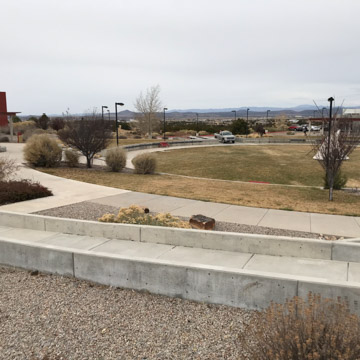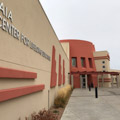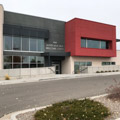Institute of American Indian Arts
The Institute of American Indian Arts (IAIA) offers a vision of the twenty-first century land-grant university campus: cognizant of the past, connected to its present, and deeply rooted in the natural landscape. Rising above the city of Santa Fe, New Mexico, with sweeping views to the foothills of the Sangre de Cristo Mountains, the expansive grounds radiate around a central, sunken circular plaza through which solstice lines and points have intersected since the campus began construction at the millennium’s turn. As of 2020, IAIA featured approximately thirteen buildings whose traditional Indigenous symbols, colors, and volumes combine with the materials, articulation, and forms of an architectural modernism. According to Indigenous scholar Rina Swentzell, the campus is intended to honor “the sanctity of all living things, the earth, and the sky.” The setting, on an elevated plain geographically separated from the colonial city of Santa Fe to its south, makes those connections ever apparent.
The IAIA campus lies just twelve miles south of the Santa Fe Plaza, the historic administrative center of Spanish Colonial power in North America. The plaza is also ground zero for prototypes of the invented architectural tradition known as Pueblo Revival or the Santa Fe style and, at least since the 1910s, the center of the city’s tourist appeal. Although IAIA has operated the Pueblo Revival Museum of Contemporary Native Arts (MoCNA) in the old Federal Building just a block from the Santa Fe Plaza since 1992, the new campus consciously avoids references to the colonial overtones of the Pueblo Revival. Instead, IAIA’s built environment attempts to echo its longstanding pedagogical philosophy of encouraging Indigenous artistic traditions while training students to incorporate their heritage into the present. In this way, the campus attempts to provide the tools—and the facilities—necessary to operate in an accelerated world of twenty-first-century artistic production while grounding that artistic training within Indigenous space and place.
That space and place is evident at the site. Noncontiguous residential development lies to the east and north of the 140-acre campus, but thousands of mostly undeveloped desert landscape extends to the west and, beyond a Seventh-Day Adventist church and a single-building charter school, to the south. In the land-grant tradition of practical training and service to the community, the new arts-oriented campus includes a demonstration garden and a greenhouse. Yet the school’s deepest connection to this mission may be its commitment to tribal outreach through the Center for Lifelong Education and its desire to provide access to higher education for Indigenous peoples who have traditionally lacked it. Representing those opportunities, the most significant element of the campus may be the sky; its presence in this high desert environment, 6,515 feet above sea level, is accentuated by low-rise buildings whose configuration seems deferent to the expansive landscape that envelops them.
The landscape of America’s land-grant institutions itself expanded in 1994, when the Equity in Educational Land-Grant Status Act was passed to assign land-grant status to twenty-nine of the nation’s tribal colleges and to provide them with endowments and opportunities for capacity-building grants. These tribal colleges already existed, but the new legislation provided them with levels of permanent, federal support which underwrote their growth. The Institute for American Indian Arts was one of the “certain Indian colleges and institutions” selected for land-grant status; its newfound federal financial support assisted its move to a new campus just six years later.
At the time, however, the existing IAIA “campus” was distributed amongst barracks at the former College of Santa Fe—its second location since the art school’s founding in 1962. The school’s original location was part of the Santa Fe Indian School campus: a Bureau of Indian Affairs (BIA)-administered high school less than three miles from downtown Santa Fe. Founded by Cherokee artist Lloyd Kiva New, the school was focused on providing arts education to high school students but it also offered a two-year, post-high school, studio-oriented elective program. It was never intended to be a traditional art school, however. The school replaced an existing art program at the BIA school with one that combined an Indigenous cultural perspective with contemporary, even experimental, methods and techniques. The curriculum did not neglect training in (and knowledge of) western art techniques and western art history—but such was not the emphasis.
New was adamant that the school should not train Indigenous artists merely to accommodate western tastes and techniques so they could better assimilate to western society. Indeed, he stressed that Native Americans must reject stereotypical notions of Indian arts and culture and keep the present visible at all times. “The future of Indian art,” he added in an early report describing the philosophy of the newly formed school, “lies in an ability to evolve, adjust, and adapt to the demands of the present, and not upon the ability to manipulate the past.” By 1978, the school gained approval as a junior college granting associate’s degrees, which included those in creative writing and museum studies along with studio art. In 1979, its high school program was phased out.
In 1980, the institution left the Santa Fe Indian School campus and moved to the College of Santa Fe, thus beginning a physical break from the authority of the BIA. This break became policy in 1986 when the institution was incorporated as the Institute for American Indian and Alaska Native Arts and Culture Development: a federally chartered, independent, non-profit institution with a board of trustees appointed by the federal government. Two years later, in 1988, a real estate development corporation, the Rancho Viejo Partnership, donated 140 acres to the school for a new campus. The school would remain in its temporary barracks at the College of Santa Fe, however, until the new grounds opened in 2000. In part because of its new, independent campus, the Institute of American Indian Arts—now with a shortened name—became a fully-accredited, four-year degree-granting institution in 2002.
The first building erected on the new site was a small wooden cultural center shaped as a Navajo hogan, set about a quarter-mile, due east, from the planned center of campus amidst piñon pines and rubber rabbitbrush shrubs. Indigenous architect Douglas Cardinal made provisions for a “cultural grounds” at that location on the original 1993 long-range development plan, but extended the majority of his characteristically amorphous, seemingly contiguous, curvilinear buildings around a central open space—the “Dance Circle”— intended to encourage “communal connections and human interaction.” Although the volumes specified in Cardinal’s plan were not ultimately built and the boxier ones that did emerge were less intimately tied to the landscape than indicated in the master plan, the central space—as well as its orientation to the cardinal points, solstices, equinoxes, and distant mountains through lines of sight and pathways—was largely retained. Curved trellises beyond the Academic Building (Weller Architects with Sinkpe Architects Planners) and Library and Technology Building (BPLW Architects) help accentuate the circular space. The Dance Circle itself, meanwhile, is sunken into the landscape; reserved for ceremonies and events, the process of descending into a circular space suggests something of a great kiva—a ritual space common to Ancestral Puebloan tribes of the region. Together with a set of dormitories for married students, these were the first buildings and spaces on campus.
Subsequent development in the early-twenty-first-century has emerged around the Dance Circle with less apparent symbolism—at least in plan. This development is marked principally by a series of buildings completed in the 2010s: the Foundry Building to the northwest, the Center for Lifelong Education to the southwest, the Barbara and Robert Ells Science and Technology Building and the Lloyd Kiva New Welcome Center to the east, and the Performing Arts and Fitness Center to the southeast. All of these buildings, along with a cruciform-shaped residence center for single students directly southeast of the Center for Lifelong Education, were designed by Dyron Murphy Architects from Albuquerque, an Indigenous-owned firm which also provided a 2010 update to the original master plan.
The Dyron Murphy buildings vary in overall size, articulation, and color, but none of them are more than a few stories tall. Most of them include varying shades of earth tones on their stucco facades, and several feature low, cast-in-place concrete walls fronted by trellis-like canopies featuring angled steel I-beams resting on concrete tube columns—a contemporary adaptation of the vigas found in the built environment of the Ancestral Puebloans. Four of Dyron Murphy’s buildings have achieved some level of LEED certification for their energy conservation and native landscaping, and nearly all of them frame views of the land and sky.
The design of buildings on the IAIA campus prompted one writer to characterize it, in 2011, as “new age adobe,” yet the new campus reflects Lloyd Kiva New’s longstanding philosophy of the school: to provide modern adaptations of Indigenous building types, motifs, and belief systems; to best represent the diverse Indigenous backgrounds from which the school population drew; and to move away from the colonial trappings of the Santa Fe style. According to Paul Fragua, a native Jemez Puebloan and IAIA staff member involved in the implementation of the early buildings of campus, it was vital that the design was “not going to be some kind of neo-tepee or longhouse or x-teenth version of the Pueblo theme.”
Regardless of aesthetics, the arrangement of buildings has always underscored the importance of the land. As of 2020, the built environment occupies less than a quarter of its overall acreage, permitting ever-present framed and panoramic views of mountains, desert, and sky. It is perhaps this evident connection to the environment, along with the facilities necessary to provide a hands-on, professionally oriented, and affordable education in the arts, that connects IAIA most explicitly to the land-grant tradition. It seems appropriate that a land-grant, arts-based education for Indigenous peoples, respectful of ancient traditions but not bound by them, would return to the landscape.
References
Dyron Murphy Architects, P.C. “Behind the Design: IAIA Lloyd Kiva New Welcome Center.” Dyron Murphy Architects, P.C. website. February 8, 2018. http://dyronmurphy.com/.
Flahive, Ryan S. “Introduction.” In Celebrating Difference: Fifty Years of Contemporary Native Arts at IAIA, 1962-2012, 13-23. Santa Fe: Sunstone Press, 2012.
Kiva, Lloyd. “Comments on Southwest Indian Arts and Crafts Project, University of Arizona…2nd Year, 1961.” Unpublished manuscript. Archives at Institute of American Indian Arts: IAIA History Reader. Accessed June 9, 2019. http://iaia.libguides.com/ld.php?content_id=3292324.
Kiva New, Lloyd. “Unity Assembly IAIA Santa Fe.” Keynote address. December 12, 1998. Archives at Institute of American Indian Arts: IAIA History Reader. Accessed June 9, 2019. http://iaia.libguides.com/ld.php?content_id=3292344.
[Kiva] New, Lloyd H. “Report on a Proposed Philosophical Approach to the Art Education Program of the Institute of American Indian Arts, Bureau of Indian Affairs, Santa Fe, New Mexico.” Unpublished manuscript. Archives at Institute of American Indian Arts: IAIA History Reader. February 5, 1962. Accessed June 9, 2019. http://iaia.libguides.com/ld.php?content_id=3292325.
Mead, Christopher C. “Museum of Contemporary Native Arts,” [Santa Fe, New Mexico], SAH Archipedia, eds. Gabrielle Esperdy and Catherine Boland Erkkila, Charlottesville, UvaP, 2012—, http://sah-archipedia.org/buildings/NM-01-049-0175.
Oliviera, Adele. “Art of Origin: Studio Arts at IAIA.” Pasatiempo (Santa Fe, NM), August 21, 2015.
Swentzell, Rina. “Dreams, Landscapes, and Sacredness at the Institute of American Indian Arts.” In Celebrating Difference: Fifty Years of Contemporary Native Arts at IAIA, 1962-2012, 109-119. Santa Fe: Sunstone Press, 2012.
Weideman, Paul. “Learning Curve: Building the Institute of American Indian Arts.” Pasatiempo (Santa Fe, NM), August 21, 2015.
Wilson, Chris. The Myth of Santa Fe: Creating a Modern Regional Tradition. Albuquerque: University of New Mexico Press, 1997.
Writing Credits
If SAH Archipedia has been useful to you, please consider supporting it.
SAH Archipedia tells the story of the United States through its buildings, landscapes, and cities. This freely available resource empowers the public with authoritative knowledge that deepens their understanding and appreciation of the built environment. But the Society of Architectural Historians, which created SAH Archipedia with University of Virginia Press, needs your support to maintain the high-caliber research, writing, photography, cartography, editing, design, and programming that make SAH Archipedia a trusted online resource available to all who value the history of place, heritage tourism, and learning.














